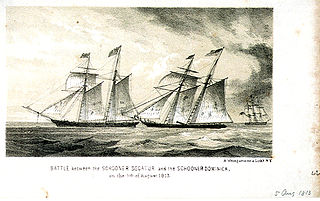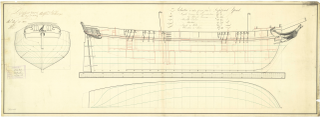
HMS Oberon was a 16-gun brig-sloop of the Seagull class built at Kingston upon Hull and launched in 1805. She was constructed at the James Shepheard Shipyard, Sutton.

HMS Belette was an 18-gun Cruizer-class brig-sloop, built by King at Dover and launched on 21 March 1806. During the Napoleonic Wars she served with some success in the Baltic and the Caribbean. Belette was lost in the Kattegat in 1812 when she hit a rock off Læsø.

HMS Surinam was a Cruizer-class brig-sloop built by Obadiah Ayles at Topsham, Exeter and launched in 1805. She captured one privateer during her twenty-year career and took part in two campaigns before she was broken up in 1825.

HMS Musquito. was a Royal Navy Cruizer-class brig-sloop built by John Preston at Great Yarmouth and launched in 1804. She was commissioned in October 1804 under Commander Samuel Jackson. She served in the North Sea and the Baltic, and Jackson supervised the first successful rocket attack in Europe at Boulogne in 1806. After the war she served off Africa and captured some slavers. She was broken up in 1822, having been laid up since 1818.
HMS Eclair was a French Navy schooner launched in 1799 and captured in 1801. The British took her into service under her French name and armed her with twelve 12-pounder carronades. In 1804 she engaged in a noteworthy, albeit indecisive single ship action with the 22-gun French privateer Grande Decide. In 1809 she was renamed Pickle. In December 1812 she and three other small British vessels engaged the French 40-gun frigate Gloire in another noteworthy and indecisive action. She was sold in 1818.
HMS Colibri was the French naval Curieux-class brig Colibri, launched in 1808, that the British captured in 1809 and took into the Royal Navy under her existing name. She spent her time in British service on the North American station based in Halifax, Nova Scotia. During the War of 1812, Colibri served mostly in blockading the American coast and capturing privateers and merchant ships. She foundered in 1813 in Port Royal Sound, South Carolina, but without loss of life.

HMS Dominica was the French letter of marque schooner Duc de Wagram, which the British captured in 1809 in the Leeward Islands and took into the Royal Navy in 1810. The American privateer Decatur captured her in 1813 in a notable single-ship action. However, Majestic recaptured her in 1814. She was wrecked in 1815
HMS Linnet was originally His Majesty’s revenue cutter Speedwell, launched in 1797, that the Royal Navy purchased in 1806. Linnet captured a number of privateers before the French frigate Gloire captured her in 1813. The French sold or transferred her to the Americans, who operated her as the privateer Bunkers Hill. In March 1814 the British recaptured her, but did not return her to service.
HMS Patriot was a Dutch schuyt that the Royal Navy captured in 1808 and took into service. She captured several enemy vessels before she was converted to a water vessel in 1813. The Admiralty sold her in 1815.
HMS Canso was the American letter of marque schooner Lottery, launched in 1811, that a British squadron captured in 1813. The Royal Navy took Lottery into service as HMS Canso and she served during the War of 1812 and briefly thereafter. The navy sold her in 1816.

HMS Moselle was a Cruizer-class brig-sloop of the Royal Navy, launched in 1804. She served during the Napoleonic Wars in the Mediterranean, the Caribbean, and the North American station. She was sold in 1815.

HMS Rover was a Royal Navy Cruizer-class brig-sloop laid down in 1804 but not launched until 1808. She served in the North Sea, off the north coast of Spain, in the Channel, and on the North American station. She captured two letters-of-marque and numerous merchant vessels before being laid-up in 1815. She then sat unused until she was sold in 1828. She became a whaler that made four voyages to the British southern whale fishery between 1830 and 1848. She was last listed in 1848.
HMS Gleaner was the mercantile ketch Gleaner, launched in 1802. She served the Royal Navy as the "hired ketch Gleaner" from 12 July 1808 until the Navy purchased her in 1809. Initially she served as a light vessel and survey vessel. From early 1811 to August 1811 she served in the Mediterranean, where she captured an Ottoman vessel. She then became a yard lighter and a light vessel again. Then in 1812 she was on the North American station where she participated in the capture of several merchant vessels. Next she returned to the Mediterranean where she captured a privateer. Finally, she served off the north coast of Spain where she was wrecked on 2 March 1814.

HMS Wanderer was a Cormorant-class ship-sloop launched in 1806 for the Royal Navy. The Royal Navy sold her in 1817. She made one voyage between 1817 and 1820 as a whaler in the British southern whale fishery. She then sailed between Plymouth and North America until October 1827 when her crew had to abandon her at sea because she was waterlogged.
Badger was launched in 1803. She served as an Excise Cutter, a hired armed cutter serving the British Royal Navy, and then as a merchant vessel. She was last listed in 1822.

Milan was a French brig built at Saint Malo, from plans designed by François Pestel that had already served for Curieux in 1800 and for Palinure in 1804. She served in the French Navy for four years before HMS Surveillante and Seine captured her. She became HMS Achates in the Royal Navy and served until after the end of the Napoleonic Wars.
HMS Juniper was launched at Bermuda in 1809 for the British Royal Navy. She participated in one campaign for which her crew was awarded the Naval General Service Medal (1847) with clasp "San Sebastian". She also participated in the capture of several merchant ships. The Navy sold her in 1814.
HMS Barbadoes was a 16-gun vessel, the American Herald, captured in 1813. The Royal Navy took her into service as HMS Barbadoes She captured a number of merchantmen and privateers before she was paid-off in May 1816. In 1814–1815 she also captured three Spanish and French vessels carrying over 1100 slaves. Barbadoes became a powder ship in Jamaica that was later wrecked with her remains being sold.
HMS Thrasher was launched in 1804 at Brightlingsea, or Colchester as the merchant vessel Adamant. The British Royal Navy purchased her in June 1804, renamed her, and fitted her out as a gunbrig. She captured numerous small merchant vessels, most of them Dutch or Danish. After the Navy sold her in 1814, she returned to mercantile service under her original name of Adamant. She made a voyage to Malta in 1815 and was wrecked as she was returning to London.
HMS Columbia was the United States privateer brig Curlew, which the British Royal Navy captured in 1812 and took into service as HMS Columbia. The Navy sold her in 1820.








